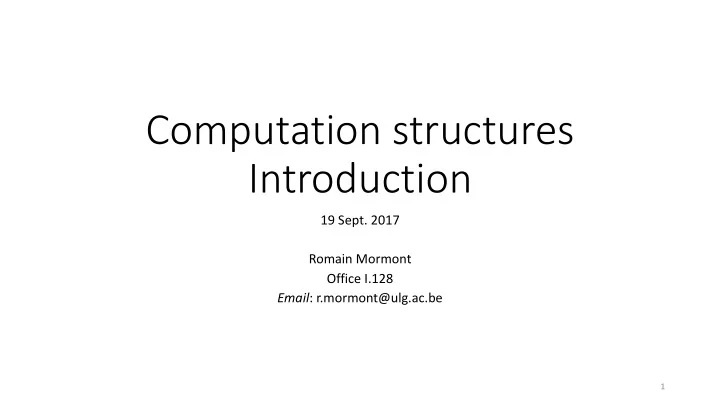

Computation structures Introduction 19 Sept. 2017 Romain Mormont Office I.128 Email : r.mormont@ulg.ac.be 1
General information • Course webpage: http://www.montefiore.ulg.ac.be/~rmormont/?rpath=/info0012 • Tutorial every Tuesday, here (R3) and now (~ from 16h to 18h) • Grading: • Two projects: 1. 𝛾 -assembly: due for first week of November (to be confirmed) 2. Parallel programming • Written exam in January 2
Computation structures Tutorial 1: : µ-code for ULg01 3
ULg01: an implementation of the 𝛾 -machine 4
ULg01: data path The data path includes: • ALU circuit: A rithmetic L ogic U nit • Static memory (DRAM) : similar to your computer’s processor registers • Dynamic memory (SRAM) : similar to your computer’s RAM ALU: • Two registers A and B for storing operands • 3 status flags can be used to implement conditional instructions: • E = 1 if ALU outputs 0xFFFFFFFF (-1) • 𝐷 : complemented carry bit • N: sign bit (bit 31) 5
ULg01: data path The data path includes: • ALU circuit: A rithmetic L ogic U nit • Static memory (DRAM) : similar to your computer’s processor registers • Dynamic memory (SRAM) : similar to your computer’s RAM Dynamic RAM : • Stores programs’ instructions and data • 4 Mbytes of memory • 1 Mword (need only 20 bits to address) 6
ULg01: data path The data path includes: • ALU circuit: A rithmetic L ogic U nit • Static memory (DRAM) : similar to your computer’s processor registers • Dynamic memory (SRAM) : similar to your computer’s RAM ( R andom A ccess M emory) Static RAM : • 32 registers : R0, …, R31 • Access to R31 always returns 0 • More « convenient » and faster than DRAM for data you need to access often in your program 7
ULg01: program counter (PC) Register containing the address of the next instruction to execute 8
ULg01: control unit • The « brain » of ULg01 ! 9
ULg01: control unit • The « brain » of ULg01 ! • The control unit is microprogrammed and the 𝜈 -code is stored in a ROM. • The 𝜈 -code defines the behavior of ULg01 for a given 32-bits instruction. 10
ULg01: microcode of OR(Ra, Rb, Rc) • ROM address: concatenation of Opcode , Phase and ALU flags • Given an address, the control ROM provides many signals that drives ULg01: LDxxxx (load), DRxxxx (drive), Latch flags, PC+,... • IMPORTANT : maximum 16 phases allowed per instruction 11
ULg01: microcode of OR(Ra, Rb, Rc) Human-readable ROM inputs ROM outputs representation 12
Representation of microcode for the tutorials ROM inputs ROM outputs 13
14
Recommend
More recommend